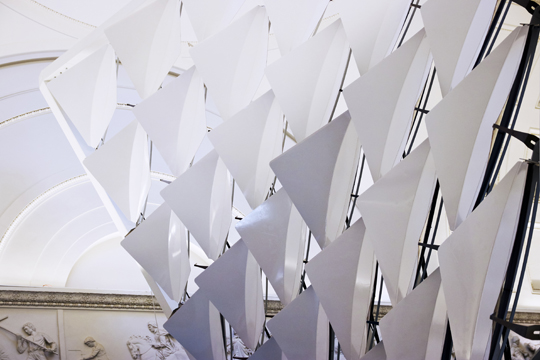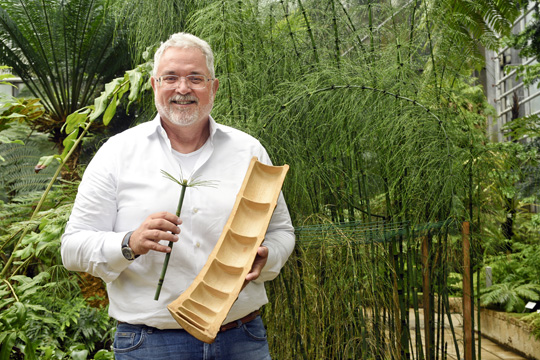Nature as a role model
Thomas Speck and his team have developed technical products based on biological principles
| From nature's inspiration to technical products: In biomimetics, researchers from the field of biology work together with colleagues from the engineering and materials sciences, architecture, physics and chemistry. The research area is located in the Botanical Garden at the University of Freiburg and plays a key role in the Living, Adaptive and Energy-autonomous Materials Systems (livMatS) cluster of excellence and the Freiburg Center for Interactive Materials and Bioinspired Technologies (FIT). In an interview with Patrick Siegert, the director of the garden and spokesperson for livMatS, Prof. Dr. Thomas Speck, explains what biomimetics is all about and what role the Botanical Garden plays in his research. |

For Flectofold (c) - a jointless and elastic shading system for building facades - the researchers were inspired by the carnivorous water trap. Picture: Flectofold (c) PBG Univ. Freiburg & ITK Univ. Stuttgart
Mr. Speck, how can visitors imagine your work in the Botanical Garden?
Thomas Speck: Our facility is primarily used for research and teaching, but the garden is also a central place of tranquility that many people visit to relax and enjoy plants. Here we also present our results of scientific work in biomimetics and botany to the public. The research team and the horticultural team work closely together. We cultivate about 6,000 plant species, some of which grow very luxuriantly, such as a giant bamboo about 20 meters high in the tropical house. In the Botanical Garden, we can display and study all the developmental phases of a plant. Our gardeners are therefore particularly challenged because they need to know a lot about botany.
One of your main research areas is biomimetics. What exactly is that?
In the professorship “Botany: Functional Morphology and Biomimetics” and the associated Plant Biomechanics Group, we are working to understand models from nature. This does not mean that we simply copy nature. In technology, we process different materials than in biology, and we also scale up and down in technical applications. Additionally, biological constructions have different energetic needs than bio-inspired technical materials and products. In my understanding, biomimetics is a creative reinvention process that begins with a discovery in nature. There are many processes leading up to the finished biomimetic product in which we check whether the developments are functional and their mechanisms are technically feasible. Together with partners from the engineering and materials sciences, but also with companies, we then transfer the results to the first prototypes, which we often also apply for patents.
What are the prototypes you are currently working on in the livMatS cluster of excellence?
In one project we are working on artificially recreating the Venus flytrap with a 4D printer. This carnivorous plant requires no external energy supply and the complex trapping process works without a central control unit, i.e. without a brain. In the end, our completely technical replica should look so real that aliens could not distinguish it from its natural model when landing on Earth. This project is intended to sound out the possibilities of biomimetic developments in the sensor-actuator field, but also offers some potential applications, for example as a biomimetic gripper. In addition, our team is researching soft robots inspired by the growth and attachment systems of lianas, i.e. robots made of particularly pliable materials inspired by nature. In 'GrowBot', an international project funded by the European Union, we are developing robots that, like climbing plants, can independently overcome obstacles and bridge larger distances. This is interesting, for example, to check power lines at great heights, but also for archaeological research or for searching for buried subjects in narrow crevices and corridors.

In the beginning there is the discovery in nature, only then comes the technological invention. Thomas Speck sees biomimetics as a creative reinvention process. Picture: Thomas Kunz
And what other plants have you learned from?
Together with partners from architecture, textile technology and industry, we have developed a biomimetic shading system for building facades that functions with jointless and particularly elastic movement mechanisms. We were inspired by the bird of paradise flower and the carnivorous water trap to develop the patented facade shading Flectofin and Flectofold. Both developments allow interactive shading, which we also want to apply in our greenhouses and in the gardener’s foothold. We compare both products with a conventional facade shade and measure how much more efficient and long-term they work.
Your team also develops products in the field of lightweight construction. Do you have an example of this?
In another project, together with the ITV Denkendorf, we have developed and patented a technical plant stem that can be used as an ultra-light, highly resilient and multifunctional structure in aerospace, architecture and rowing. By incorporating tube-like structures - such as those found in the stalk wall of horsetails - into fiber composite structures whose fiber angle and distribution are inspired by bamboo and giant reed stalks, the product becomes particularly light and stable. For branched bio-inspired supporting structures, we also use fiber composites whose outer shape and fiber arrangement is similar to the branches of candelabra cacti or dragon trees. The structure can be filled with lightweight concrete, which consumes up to a third less concrete mass and reduces CO2 emissions.
The Botanical Garden has been in existence for 400 years. What are your hopes for its future?
The Botanical Garden is highly regarded by the Faculty of Biology and the entire University of Freiburg for its research projects, the guided tours it offers and the biomimetic nature trail. We regularly receive new requests for cooperation from industry and raise a lot of third-party funds. This successful work should continue in the future. For the time after my retirement, I hope that the Botanical Garden will continue to be centrally involved in research - regardless of its focus. As former president of the Association of Botanical Gardens, I have experienced the difficulties faced by those institutions that are cut off from research. In the livMatS cluster of excellence, we also want to create another professorship that will complement the biological side of biomimetics with the perspective of engineering sciences, for example. In the Plant Biomechanics Group and the Botanical Garden, women make up half of the senior staff. Overall, compared to other technical research areas, many female scientists work in biomimetics. We want to continue to promote this development in the future.
Patrick Siegert


